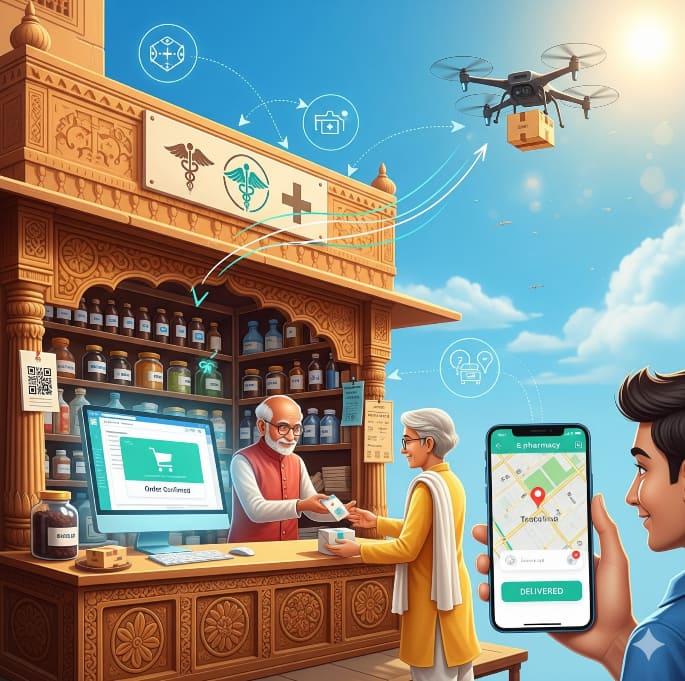E-pharmacies and traditional chemists must collaborate to strengthen India’s healthcare system. By combining digital convenience with local trust, they can improve medicine access, affordability, and quality for millions across urban and rural India.

(Source: AI Image)
E-pharmacies are an essential addition to the traditional healthcare landscape of India as it takes a leap toward digitalization and needs a solution to several barriers to medicine accessibility and quality that have existed since the dawn of modern healthcare. But this revolution has not passed without opposing. Conventional pharmacies and the associations that they form, which have been controling India in the field of pharmaceutical retailing, tend to view e-pharmacies as a source of disruption. Yet rather than competing there is a potential opportunity to come together so the two format can help improve the provision of healthcare to millions of Indians.
The Role of E-Pharmacies in India
More than 40 per cent of the nation does not have convenient access to pharmacy, so e-pharmacies are meeting a significant notch in healthcare. With digital infrastructure and connective logistical supply chains, e-pharmacies are able to deliver life-saving medicines to high need rural and semi-urban regions through more than 20,000 pin codes across India.
“E-pharmacies are creating a new distribution layer that directly connects patients, particularly those with chronic conditions, to essential medicines. Furthermore, they are a convenient option for those unable to leave their homes or dependent on others for medicine procurement,” explains Nirupama Soundararajan, Co-founder and CEO, Policy Consensus Centre.
In addition to cost-of-service, prices are also another major priority where e- pharmacies add value. By reducing the transactions costs and removing the middle layer, such platforms frequently provide drugs at a 15-25 per cent cheaper price than the convention forms. On the side of the consumers, it has been a game changer to have the capability to make a comparison of the online prices and have access to cheap generic drugs.
Despite the e-pharmacies cost-efficientness and convenience, the presence of an established brick-and-mortar chemist is not welcomed and many see them as competitors of their wealth. Yet, the scholars believe that the peculiarities of market conditions in India make the cooperation between individuals and their associations the only way towards the future of healthcare.
A Case for Collaboration
This has given way to heated aftereffects as the opponents of traditional chemists associations like the All India organisation of chemists and druggists (AIOCD) have raised issues over this issue vigorously. These associations have been against the establishment of e-pharmacies, and this has been due to issues of the disruption of the market and the loopholes that will arise about regulations. But such arguments have been disputed by both consumer activists and policy makers.
According to Pradeep S. Mehta, Secretary General of CUTS International, there is a need to have these two forms cooperate:
"The retail associations like AIOCD have been opposing much-needed market digitalisation because of their vested interests. In the past, AIOCD and their affiliates have been pulled several times by the Competition Commission of India for their anticompetitive practices. Instead of opposing e-pharmacy, the brick-and-mortar retailers need to collaborate with digital platforms, which also need them to serve the last mile. Such a collaboration will be a win-win situation.”
Two formats supplement each other. Conventional chemists offer proximity, immediacy and a relationship of trust between the consumer and the chemist, whereas on e-pharmacies, the situation is the reverse, in terms of logistics, control of the administration of digital prescriptions and having a wider range of medications. When combined, these strengths could increase access to healthcare throughout the country and influence the consumer experience in a positive way.
As an example, hybrid models where local chemists team-up with e-pharmacies to provide them with fulfillment capabilities, would close the last-mile delivery gap and contribute to local pharmacies remaining competitive in a digital-first market.
Regulatory Challenges: A Major Hurdle
Considering the lack of regulatory clarity, cooperation will be a viable step forward in the e-pharmacy industry. The existing regulations in the Drugs and Cosmetics Act and the Pharmacy Act are created around the usual retail model and do not adequately take into consideration the more complicated nature of digital marketing.
Mehta says, There clearly exists a regulatory deficit in the e-pharmacy space. The present framework...is quite old and does not take into account the nuances of digital markets. Some efforts in the recent past were made by the government to regulate e-pharmacy, but none could see the light of the day. The ensuing policy uncertainty is not only adversely affecting investment in and growth of this sector, but is also leading to misinterpretations by courts, adding to the ambiguity."
Such a source of regulatory uncertainty is not isolated to e-pharmacies. It also affects traditional chemists who tend to believe that digital markets have an unfair position. A contemporary, homogenised set of guidelines that will harmonise the needs of the consumer with innovation is long overdue that would give all the stakeholders a level playing field.
Technology as a Bridge
Technology is becoming highly important in the provision of safety, transparency, and efficiency of e-pharmacies. Prescription validation through the deployment of AI-enabled tools, solutions that trace the supply chain, and the comprehensive digital records that regulators can audit in a systematic way are being used on prescription platforms.
Soundararajan reiterates, As Soundararajan emphasizes, “The growth of e-pharmacies must be accompanied by strong safeguards like technology-enabled verification and regulatory oversight to ensure quality and safety for consumers.”
Such developments may help traditional chemists as well, as they can implement technologies, such as inventory management system and digital payment systems to become more efficient, and provide better customer experience.
The Future: Developing a Healthcare Ecosystem that is Inclusive
The Indian healthcare eco-system is at a crossroad. The emergence of e-pharmacies will not pose a threat to conventional chemists but will present the two formats with a chance of integrating and thus becoming more powerful together.
“History and experience suggest that it is never a zero-sum game. Different formats can not only coexist but also thrive,” Nirupama points out.
A symbiotic model that exploits the opportunities presented by both e-pharmacies and brick-and-mortar stores has the potential to bring great advantage to the consumers, companies and the healthcare system on the whole. In conjunction with regulatory clarity, such alliances can become the foundation of a digital-first health-tech environment with focus on access, affordability, and quality healthcare.
To realize this vision, stakeholders have to overcome the competitor mind-set and instead work towards collective objectives of delivering life-saving medicines to all patients, wherever they live and whatever their income with the efficiency and trust they deserve.
Empower your business. Get practical tips, market insights, and growth strategies delivered to your inbox
By continuing you agree to our Privacy Policy & Terms & Conditions
